Yoshimura history – 13
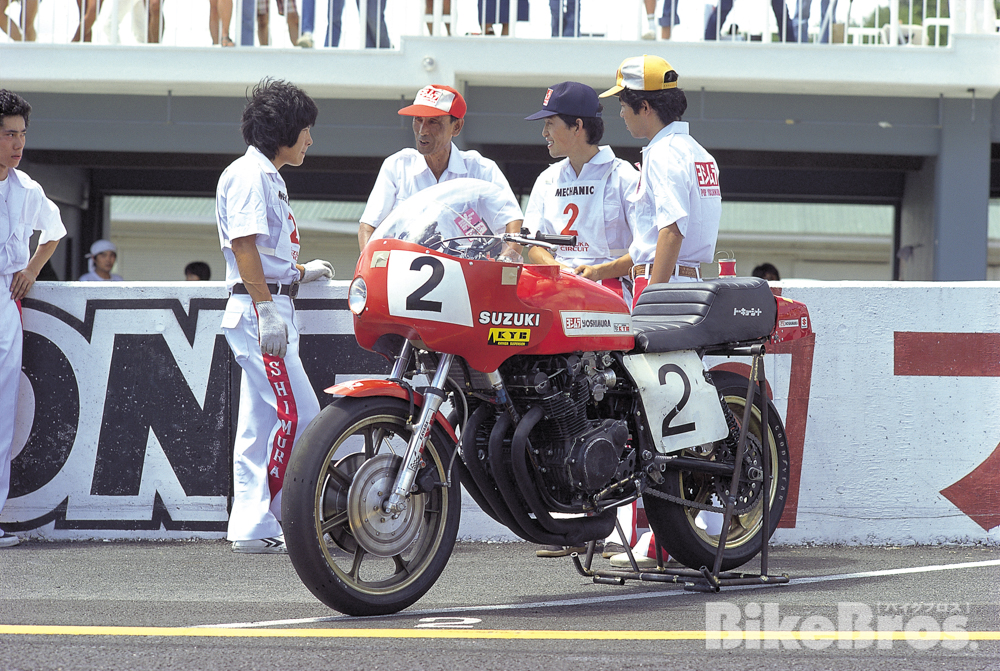
From left to right: Yoshimura mechanic Asakawa, Pop, mechanic Oya and Shohei. The Yoshimura Suzuki GS1000, which is fitted with a set of practical and efficient 29mm smoothbore Mikuni’s, along with special KYB front and rear, took grid position two.
Yoshimura History #13: Behind the First Suzuka 8H Victory
1978 Suzuka 8 Hours: Winning a Multi-Front Battle
It was during the autumn of 1977 that Pop and Fujio heard about the 8-hour endurance race, which would be held in Japan at Suzuka Circuit as a non-title international event. Yoshimura at that time had not yet received the GS1000 from Suzuki, but they knew it would be a great opportunity to demonstrate the bike’s performance and capabilities.
Pop had a special feeling about the endurance racing at Suzuka, especially since in the memorable 1964 MFJ Suzuka 18-Hour Endurance Race, one of his teams —- with riders from Gannosu, Kyushu —- won the race by defeating Honda R&D’s in-house race team. Back then the bike was Honda CB72/77. This time, it’s Suzuki GS1000.
The endurance racing at Suzuka began in 1964 —- initially as a 18-hour race, then the race duration progressively changed to 24-hour to 12-hour to 10-hour and finally to 8-hour —- and was temporarily discontinued in 1973 due to global oil crisis. The race returned as the All-Japan Championship Suzuka 6-Hour Endurance Race on June 5, 1977, in which a Yoshimura-powered Egli Kawasaki Z2 ridden by Shohei Kato / Fukui Saiji took 2nd place in the Prototype Class. Meanwhile in Europe, Honda RCB1000 racers —- known as “the invincible fleet” —- have been dominating the FIM Endurance Cup since their debut in 1976, missing only one podium in two seasons. Hence, the 1978 Suzuka 8 Hours had seemed likely to be a triumphal return for the Honda Endurance Racing Team.
Although AMA Superbike races are sprint races, Yoshimura had by then gained enough confidence in endurance races, particularly from their success in the Ontario 6-Hours in which they snatched a victory with their radically modified Kawasaki Z1. They figured that even with a sprint setup, they can be reliable enough for 8 hours and win the race!
The question is, how fast is the Honda RCB1000? The RCB has not yet been raced in the U.S., but according to stateside magazines, its lap times on European racetracks are equivalent to those of Yamaha TZ350 production racer. If that is accurate, then Yoshimura has a good chance against Honda, as their GS750/944’s and Z1’s have been setting lap times as quick as TZ350 on U.S. racetracks such as Ontario, Riverside and Willow Springs. Another concern is the Suzuka lap time. The fastest Suzuka lap at that time was 2:16.2 recorded by Yamaha factory rider Hideo Kanaya on a YZR500 factory GP racer in October 1975. Given that, and supposing that both GS1000 and RCB are as fast as TZ350, would there be any chance to crack the 2:20 barrier?
The Suzuki GS1000 which Yoshimura had built for the 1978 Suzuka 8 Hours was a AMA Superbike-spec “sprint” variation fitted with a front fairing and a quick-fill fuel tank. The engine was fully tuned with no detuning —- with no consideration for the purpose of endurance racing —- whatsoever. The bike was built at Yoshimura Parts Shop Kato in Atsugi, Kanagawa, by Shohei and mechanic Koji Oya, who was the first official “Yoshimura” employee in Japan. The second employee Kunio Asakawa, who has been the fastest rider in Shohei’s “Yoshimura R&D” race team, was assigned to be the test rider filling the spot held by Shohei who sustained a fracture in a racing accident back in April.
The engines for Yoshimura Suzuki GS1000 had received modifications after the 1978 AMA Superbike season opener in March, to deal with the cam chain flutter during extreme acceleration/deceleration that consequently smashes the tensioner slipper and in the worst case causes valves to hit pistons. To solve this long-standing issue, Yoshimura modified the cylinder head, first by integrating a guide roller into it and installing an idler gear between the cam sprockets to apply tension to the cam chain from above (a mechanism similar to that used on the stock GS750), and then by installing an additional idler gear into the bottom rear section of cam chain tunnel in the cylinder head, that works in conjunction with a shortened cam chain slipper (with the top half cut off).
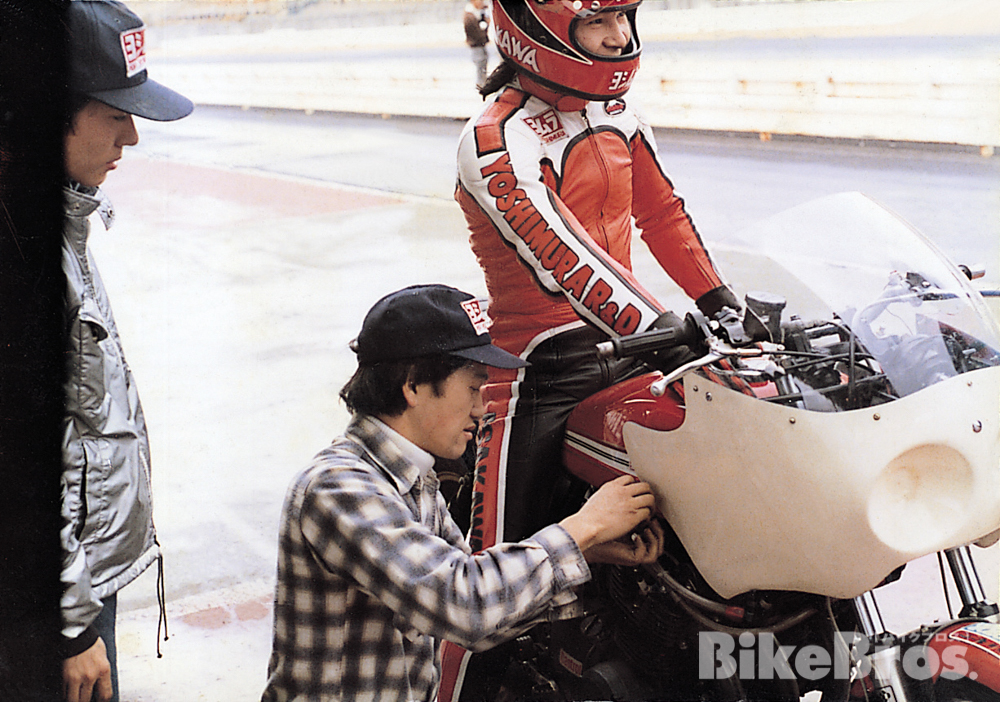
Asakawa shakes down the Yoshimura Suzuki GS1000 Suzuka 8H racer on the Fuji Speedway. “Even with the 6000rpm break-in rev limit, I easily beat my personal best,” he commented in astonishment of what the bike is capable of.
Pop returned to Japan in mid-July and began tuning the GS1000 8H racer at Yoshimura Parts Shop Kato with Shohei and Oya. The shakedown of the bike was performed at Fuji Speedway by Asakawa. Following the arrival of Wes Cooley and Mike Baldwin, the bike went through pre-race tests at Suzuki’s Ryuyo Proving Ground. Both Cooley and Baldwin beat Asakawa’s best time within a few laps. Fujio had to wait for new Goodyear slick tires (4 sets of front and rear) to arrive in North Hollywood shop before he took the plane to Japan to join the team.
Now it was time to move to Suzuka, and Moriwaki allowed Yoshimura to use their facility as a frontline base. Pop’s got his whole family on his side! At Suzuka, a total of 43 machines had shown up to compete in the 8-hour endurance race. Yoshimura signed Cooley and Baldwin to ride their GS1000, while Moriwaki signed Graeme Crosby and Tony Hatton to ride their Kawasaki Z1. Moriwaki at first tried to sign Mike “The Bike” Hailwood, but the international Grand Prix star could not make room in his schedule. If Hailwood had managed to enter the race, he might have won both the Isle of Man TT (with the Ducati 900) and the Suzuka 8 Hours in the same year.
As the practice run began, the GS1000 8H racer showed a weakness in the clutch, as it kept falling apart whenever the rider tried to crack the 2:22-2:23 barrier. No one was really sure what was causing the trouble — one cause might have been the excellent friction properties of Suzuka tarmac —- but it was a known issue since before its Superbike debut at Daytona. Yoshimura team kept replacing the clutch, and the Suzuki liaisons for the team kept bringing factory clutch components to the track until Thursday, when the team solved the problem by installing a full set of 6 heavy-duty damper springs on the clutch —- instead of the original combination of 3 heavy-duty and 3 soft springs —- as the softer springs were collapsing and exceeding the threshold of the primary gear’s radial damping slot movements while under full load (acceleration/deceleration). In such case, the 3 rivets that hold the clutch basket to the primary gear become subjected to excessive shearing stress and likely to cause the breakage of the whole clutch system!
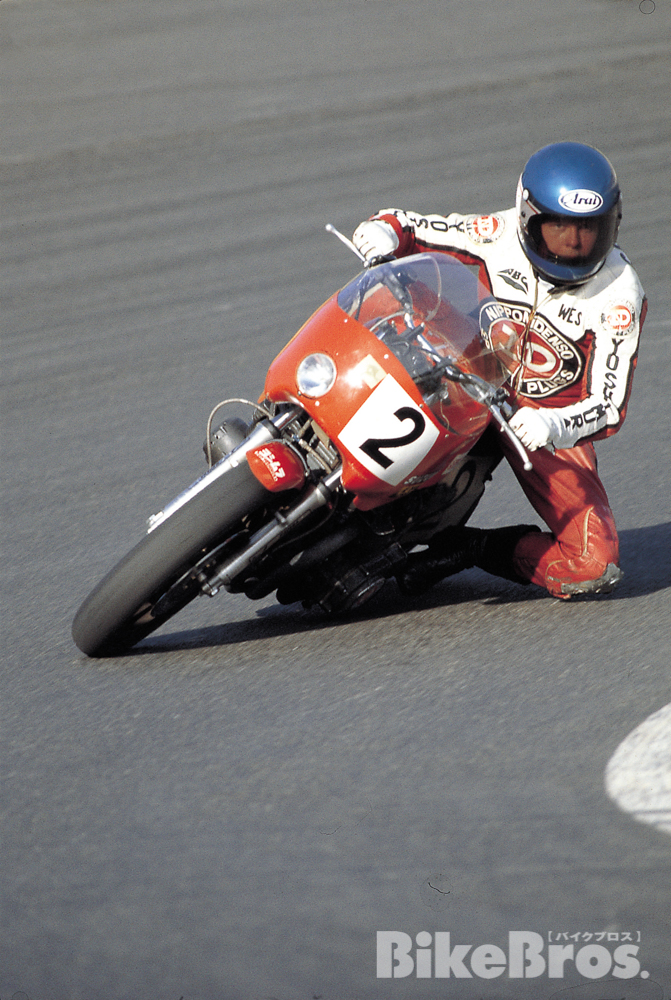
Wes Cooley showing off the potential of an AMA Superbike rider. His cheerfulness and vigor —- embodied in his stylish race suit and the hanging off, knee-dragging riding style —- were like a fresh SoCal breeze, and everything about him was a “cultural shock” for the Japanese motorcycle racing scene accustomed to the Euro-style.
One thing solved, but then another one came up, and this time it had developed into a dispute between father and son. When the team was discussing about the selection of clutch plate, Pop decided to stick with the dimpled plate that they had been using so far, whereas Fujio insisted to replace it with untreated plain type to allow more slip. Fujio’s suggestion was logical one, however, they had no experience at all with the plain type. The seemingly endless argument was terminated by Pop’s exclaim, “If you’re just going to get in my way, then go back to where you came from!”
“Well, then I’m going back to the States,” Fujio replied as he left the pit, packed his stuff in his suitcase and called a cab. He did not listen to anyone including his four brothers and sisters —- Mamoru and Namiko Moriwaki; and Shohei and Yumiko Kato —- who all desperately tried to stop him from leaving, until Cooley approached and told him to just wait until the qualifying is over. Fujio eventually took the advice of Cooley, who was close to his age and like a brother to him. Maybe it was the foreign language that made Fujio come back to his senses, but anyhow he was pleased to witness Cooley / Baldwin take the 2nd place in the qualification with a lap time of 2:21.20. The pole position was taken by Isoyo Sugimoto / David Emde on Yamaha TZ750D with 2:19.23, smashing the 2:20 barrier. The 3rd place was Crosby / Hatton on Moriwaki Kawasaki Z1, the 4th was Christian Leon / Jean Claude Chemarin on Honda RCB1000, and the 5th was Masahiro Wada / Akihiko Kiyohara on Kawasaki KR350. The 2nd, 3rd and 4th place qualifiers all marked the 2:21’s. The results were about as expected.
Fujio returned to the pit and began what he had to do, without talking with Pop. Then around midnight, while Fujio was doing the routine tappet adjustment, he discovered that one of the valve springs was broken! Strangely enough on that particular day, against his pre-race engine inspection routine —- which usually consists of checking tappet clearances, valve leaks and head bolt torques —- he took the camshafts off. “Was it a hunch? A revelation? I don’t know,” Fujio still wonders. The repair took the rest of the night, but they were fortunate in a sense to fix everything needed to be fixed before the main race.
Moriwaki Z1, on the other hand, was suffering from excessive drive chain stretch since it was running a non-sealed chain, whereas Yoshimura GS1000 was given a special sealed chain made exclusively for the Suzuki factory. Suzuki engineer Etsuo Yokouchi who heard this from his liaisons, provided the Moriwaki team their last spare chain stocked for the Yoshimura team. Moriwaki is both enemy and family to Yoshimura. Yokouchi knew that he would regret if he didn’t do this.
July 30, at 11:30 AM, the 8-hour race began. Yoshimura GS1000 ridden by Baldwin took the first lap lead. Right after the leading pack consisting of Yoshimura GS1000, Yamaha TZ750D, Moriwaki Z1 and Kawasaki KR350 did their first lap, a puff of dust arose at the final corner. It was Stan Woods’ Honda RCB, revealing that “the invincible fleet” might have already begun to fall apart. Then, from the leading pack, the KR350 dropped out due to a broken handlebar. The KR350 later charged back and retook the 4th place before retiring from the race with water pump failure. On Lap 47, Cooley built a lap lead over 4th place RCB, which then stalled at the overpass. Leon pushed the RCB back to the pit and found that it was a valve issue. The RCB was in the midst of Lap 67, while Baldwin was entering Lap 75.
Pop kept standing at the pit-board area. To Pop, a race is a war, and he believed that the leader must stay on the frontline. He was listening to the engines. His bike sounded sweet.
Hanging off. Knee dragging. Power wheelie out of hairpins. The American riding style of Cooley and Baldwin was so fresh and exciting to the Japanese audience.
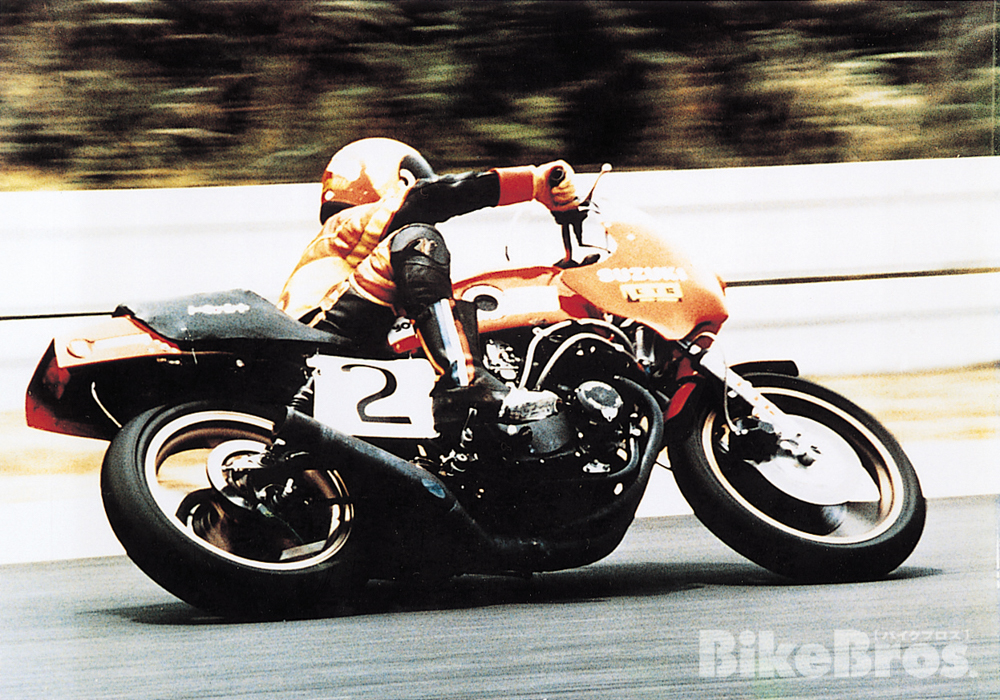
Mike Baldwin is not just one of the top American riders — he had previously scored two AMA Superbike wins riding Moto Guzzis —- but a great mechanic who could solve the problem calmly during the Suzuka 8H race.
In the 4th hour of the race, Cooley returned from his second session to the pit for a rider change and tire changes (tire change rule back then was once each on both ends per 4 hours). The rear tire change was carried out by Baldwin and Oya. Cooley and Asakawa were working on the front end, when Cooley broke one of the fork-end studs (on the left side) with an air wrench. Luckily, a small portion of the screw threads has remained —- two to three ridges sticking out from the face of the front axle holder —- just enough to fasten the front axle. “OK, I’ll do my session. Figure out how to repair it before I get back,” Baldwin said as he left the pit. After about 15 laps, he returned to the pit and said, “just grind the axle holder to make it thinner!” The rest of the team had come to the same conclusion as he did. Cooley took the GS1000 onto the track and the crew told him to pit in just as they finished fabricating a custom piece from a spare axle holder. The repair was done extremely quick, thanks to Baldwin’s calmness and Yoshimura’s passion for victory.
The TZ750D took the 1st place while the Yoshimura team was solving the axle holder issue, then the GS1000 soon retook the 1st place whilst the TZ750D pitted due to drive chain stretch (hence the necessity of a sealed chain). Moriwaki took the 2nd place until it stopped at the spoon curve due to a lack of fuel. Hatton pushed the Z1 back to the pit —- which was expected to take at least 30 minutes, but he did it in 15 minutes —- and fell down on the pit floor as Crosby took the Z1 out onto the track. Its fuel tank wasn’t empty. In all the panic, Hatton had forgotten that it has a reserve. Under the darkened sky, Crosby began to lap at an incredible pace in the 2:22 range, pushing hard to catch the 2nd place TZ750D, which was about 3 laps ahead of him.
Cooley was at the 1st place, pulling out almost 4 laps lead over 2nd place. On Lap 194, after 8 hours and 2:51.53 of racing, Yoshimura Suzuki GS1000 received the checkered flag. The promise between Pop and Yokouchi —- winning a World Championship class race in the 1978 season —- was thus fulfilled.
But the story does not end here. While Pop and his team celebrate the victory under the fireworks, Asakawa noticed how bad the condition of the GS1000 was in. “One of its down tubes, and one of its rear damper rods were cracked. I couldn’t believe my eyes that it actually got to the finish line,” he recalls. The goddess of racing must’ve been kind to Pop and his team that day.
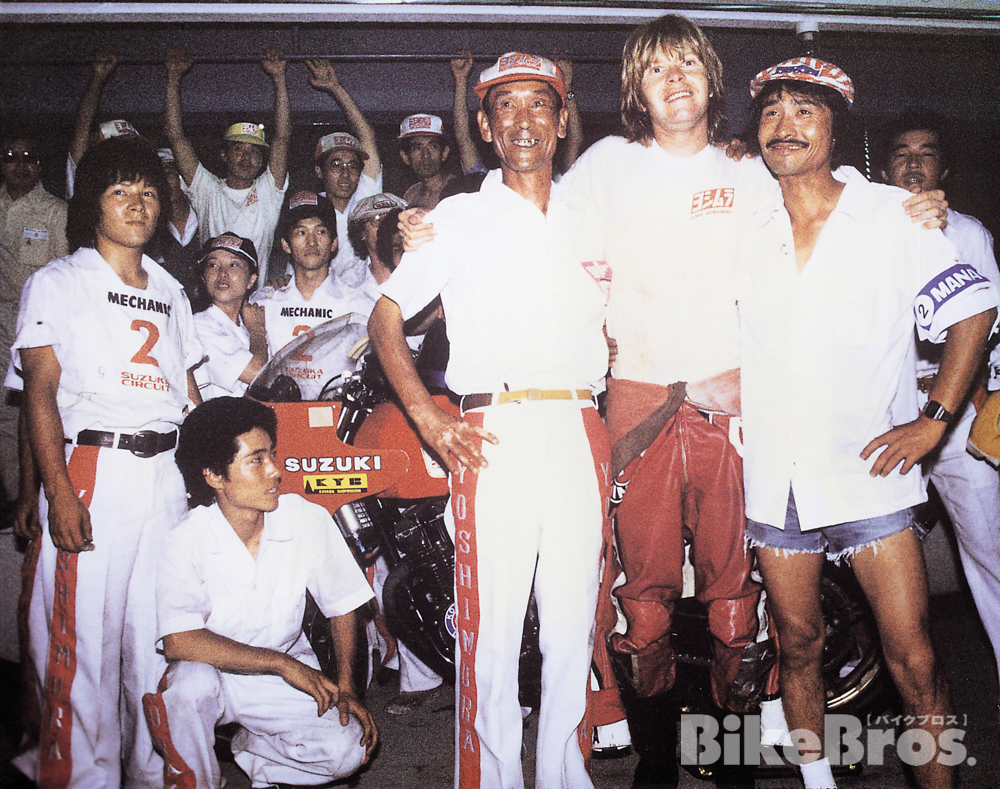
Pop, Cooley and Fujio finished the first Suzuka 8 Hours with wide, happy grins on all of their faces. It’s hard to believe what happened the day before. The gloom on the face of Mechanic Asakawa (at left) seems to suggest the condition of the bike.
============================================================
Published on February 4, 2021
Stories and photos supplied by Yoshimura Japan / Road Rider Archives / GPI/VEGA / Takao Isobe
Written by Tomoya Ishibashi
Edited by Bike Bros Magazines
[ Japanese Page ]
